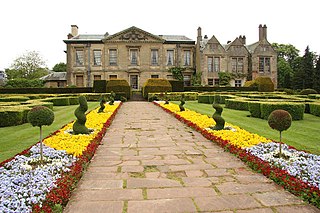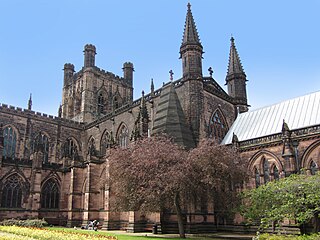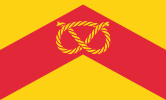
Basingwerk Abbey is a Grade I listed ruined abbey near Holywell, Flintshire, Wales. The abbey, which was founded in the 12th century, belonged to the Order of Cistercians. It maintained significant lands in the English county of Derbyshire. The abbey was abandoned and its assets sold following the Dissolution of the Monasteries in 1536.

The Abbey Church of Saint Peter and Saint Paul, Shrewsbury is an ancient foundation in Shrewsbury, the county town of Shropshire, England.
Luffield Abbey is a place in the very north of Buckinghamshire, England. It is on the border with Northamptonshire, close to Biddlesden and Silverstone.

Coombe Abbey is a hotel which has been developed from a historic grade I listed building and former country house. It is located at Combe Fields in the Borough of Rugby, roughly midway between Coventry and Brinklow in the countryside of Warwickshire, England. The house's original grounds are now a country park known as Coombe Country Park and run by Coventry City Council.

Hugh of Cyfeiliog, 5th Earl of Chester, also written Hugh de Kevilioc, was an Anglo-Norman magnate who was active in England, Wales, Ireland and France during the reign of King Henry II of England.

Chester Cathedral is a Church of England cathedral and the mother church of the Diocese of Chester. It is located in the city of Chester, Cheshire, England. The cathedral is dedicated to Christ and the Blessed Virgin Mary. Since 1541 it has been the seat of the Bishop of Chester.

Trentham Estate, in the village of Trentham, is a visitor attraction located on the southern fringe of the city of Stoke-on-Trent in Staffordshire, United Kingdom.

Rocester is a village and civil parish in the East Staffordshire district of Staffordshire, England. Its name is spelt Rowcestre in the Domesday Book. It is located on the Derbyshire border.

Curzon Park is an upmarket residential suburb of Chester, Cheshire in England. The area, which adjoins the southern banks of the Dee, was first laid out in the 19th century. It is situated next to the Grosvenor Bridge and is well known for having some of the city's largest and most prestigious residences.
Dieulacres Abbey was a Cistercian monastery established by Ranulf, Earl of Chester at Poulton in Cheshire. It moved to the present site at Abbey Green near Leek, Staffordshire in 1214, possibly in part as a result from raids at the former site by the Welsh.

Deene Park, the seat of the Brudenell family since 1514, is a country manor located 5 miles northeast of Corby in the county of Northamptonshire, England. The hall itself is a Grade I listed building dating back to the 14th century which has been modified several times since then to create the current structure.

Merevale Hall is a private country house in Merevale, near Atherstone, Warwickshire. It is a Grade II* listed building. The estate descends from Merevale Abbey which once stood on the site.

The Forests of Mara and Mondrem were adjacent medieval forests in Cheshire, England, which in the 11th century extended to over 60 square miles (160 km2), stretching from the Mersey in the north almost to Nantwich in the south, and from the Gowy in the west to the Weaver in the east. Mara and Mondrem were a hunting forest of the Norman Earls of Chester, established soon after 1071 by the first earl, Hugh d'Avranches. They might earlier have been an Anglo-Saxon hunting forest. Game included wild boar, and red, fallow and roe deer.
Elizabeth de Vere, Countess of Oxford, formerly Elizabeth Trentham, was the second wife of the Elizabethan courtier and poet Edward de Vere, 17th Earl of Oxford.
Thomas Trentham (1538–1587) was an English politician.

Sawtry Abbey was a Cistercian abbey located between Sawtry and Woodwalton in Cambridgeshire, England. The abbey was founded in 1147 by Simon II de Senlis, Earl of Northampton, who was the grandson of Earl Waltheof and Judith, the niece of William the Conqueror who held the manor when the Domesday Survey was compiled. It is the only Cistercian abbey in the county.
Horton Priory was a priory at Horton in Dorset, England.
Trentham Priory was a Christian priory in North Staffordshire, England, on an unknown site near the confluence between the young River Trent and two local streams.
Richard Trentham was an English politician.












